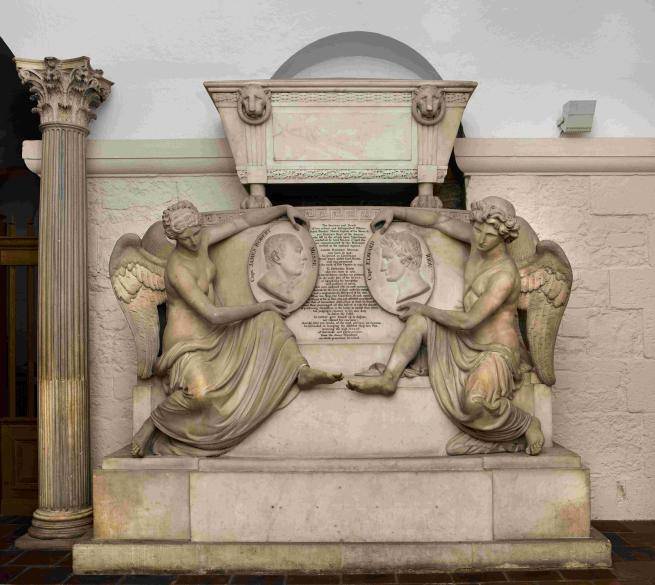James Mosse and Edward Riou

Image courtesy of Pantheons – Sculpture at St Paul's Cathedral (c.1796–1916) (york.ac.uk)
James Mosse and Edward Riou
Part of War and resistance in the Caribbean: The monuments at St Paul's: A digital trail produced in collaboration with SV2G.
The following entry has been researched and written in collaboration with members of SV2G.
Note: We are only at the start of the journey toward centring the Caribbean voice in the Revolutionary Wars. The campaigns have traditionally been documented without a focus on the impact on local populations. Although the archival records offer limited information and this area of historical study is under-developed, our project raises awareness about the activities of the British campaigns in the Caribbean and their lasting legacies, and introduces visitors to a number of Caribbean heroes.

1745-1801 (Mosse) and 1762-1801 (Riou)
Captain Edward Riou was a well-known explorer and sailor, much celebrated for his heroic death at the battle of Copenhagen against the French. However, his early naval career had been forged first in the Caribbean. In 1794 he travelled to Jamaica with Sir John Jervis, Earl Saint Vincent, in the large naval expedition to invade Saint Lucia, Martinique, and Guadeloupe, three French possessions of immense value owing to the productivity of their plantations. At the storming of Fort Royal in Martinique, Riou commanded the so-called ‘flatboats’ that had been integral in the wars against the French during the American Revolution. Captain Riou’s rising naval career in the Caribbean saw him put in charge of a 40-gun ship, and he successfully captured several French ships.
Similarly, Captain James Mosse had a long naval career, going to sea aged 11, and criss-crossed the Atlantic serving in campaigns in the Caribbean and Europe between the 1750s and 1780s.
But the Atlantic Ocean and the Caribbean Sea were not just an arena for the British to showcase its naval capacities: it was a place of displacement, dislocation, enslavement, and death, for millions of enslaved Africans, free, and indigenous people of colour.
For young British officers early in their careers, the Caribbean also posed great dangers and was not a popular destination. With large numbers of the Royal Navy dying of yellow fever and battle wounds, the need arose to recruit black soldiers to fight for them. Conflict arose among the local populations about whether to support the British or the French. Alongside white British, French, German, Dutch, and Spanish officers, black and mixed-race soldiers of all backgrounds (enslaved peoples, runaway slaves, and free men of colour who were sometimes slave-owners themselves) chose which side to fight on, depending on their chances of survival, political persuasions, economic needs, and personal interests. The British faced a dilemma: while needing black bodies to replace their soldiers, they also had a constant fear that by training and arming them, they would in turn use their weapons against them and their owners. Thus when a proposal was put by the Governor of Barbados to the House of Assembly to raise five black regiments consisting of 1,500 men, it was denied for this very reason.
The French Revolutionary Wars of 1792-1802 and the Napoleonic Wars of 1803-1815 destroyed millions of lives. Although the wars are not usually given the name ‘world war’, the conflicts were global in their reach and their repercussions were lasting and worldwide. All levels of society were affected by the revolutionary wars in the Caribbean, from the local enslaved and free populations to ordinary British and French soldiers. Alongside rape, torture, corporal punishment, and banishment, families were separated, children were orphaned or borne out of wedlock, and ordinary people experienced the turmoil of prolonged military conflict.
While the physical remnants of war remain in the Caribbean, few archives have documents revealing the lives of the indigenous peoples and enslaved Africans. Once legally recognised as personal property rather than human beings, the majority of enslaved Africans were not literate and were thus unable to write down their own stories. Today the descendants of enslaved Africans and indigenous peoples still rely on the documents produced by those who colonised the islands. Nevertheless, they have continued to preserve and tell their history through the transmission of memory and heritage. For this project, St Paul’s Cathedral worked with the arts and heritage group SV2G (St Vincent and the Grenadines 2nd Generation) to explore the history of the British Empire in the Caribbean. The aim was to understand shared pasts in order to shape our shared future, using the collection of monuments to promote conversation, debate and action.
Listen to an audio-recording of this text read by a member of SV2G. Sound recording by Marlon Lewis, Life in Frames.
For detailed information about this monument, visit the Pantheons: Sculpture at St Paul's Cathedral website.

War and resistance in the Caribbean
The monuments at St Paul's
Explore the full digital trail produced in collaboration with SV2G.




